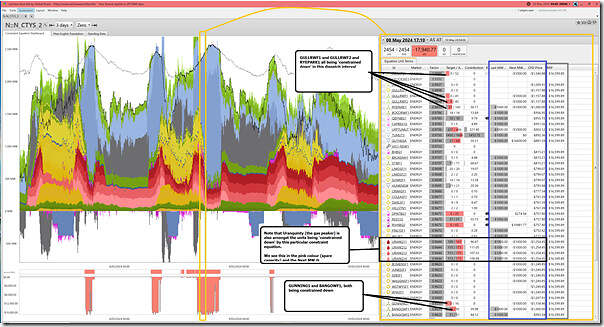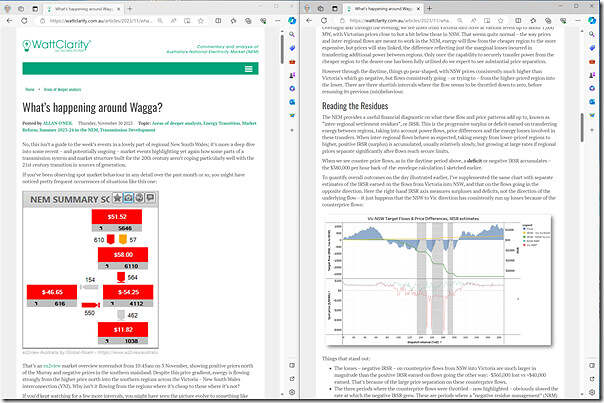Can’t shake the curiosity about what happened on Wednesday 8th May 2024, so am going to keep exploring in spurts.
Apologies that this short article will be a bit cryptic at this point, for some readers (hopefully clearer later with subsequent articles being posted) –
(A) Binding of the ‘N::N_CTYS_2’ constraint equation (amongst others)
There were a number of constraint equations bound over the >4 hours of volatility experienced on Wednesday afternoon/evening … so readers should not mistakenly read that it was just this one that was material.
A1) The Constraint Dashboard widget
For several reasons I want to post this snapshot of the ‘N::N_CTYS_2’ constraint equation, time-travelled back to 04:00 this morning Friday 10th May 2024 … so:
1) extending more than 24 hours into the ‘NSW under Administered Pricing’ regime,
2) but also spanning the volatile periods of Tue 7th May evening, Wed 8th May morning, and Wed 8th May evening.
For those who are not licensed to ez2view and so not familiar with this widget it is quite busy, but also quite powerful. Whilst the time-travel point (setting the context for the whole window) is 04:00 this morning, I’ve specifically selected the 17:05 dispatch interval on Wed 8th May in the chart to set the context of the table on the right:
Click on the image to open in larger resolution on second tab
With respect to this image:
1) All the DUIDs shown are located in NSW … we can see this with reference to the sky-high RRP for the 17:05 dispatch internal for each DUID.
2) Because of the different LHS factors (and possible presence of other constraint equations), the CPD Price is different for each DUID:
(a) For a generator, they need to be bid at or below the CPD Price in order to dispatch … we can see where they are bid in the ‘Next MW @’ and ‘Last MW @’ columns, and the shading shows how much of that bid band was dispatched.
(b) For a scheduled load, the logic is just reversed.
3) In particular I have highlighted a number of units that were all being ‘constrained down’ by this constraint equation and possibly other constraint equations as well (we’d need to look at the ‘Unit Dashboard’ for each individual DUID to see if other constraints were binding at the time).
(a) There’s a number of wind farms ‘constrained down’ by this (and possibly other constraints) – including COLWF01, GULLRWF1, GULLRWF2, etc… (reading from the top)
(b) But important to note that Origin Energy’s Uranquinty gas-fired peaker is also being constrained down (just in this dispatch interval there’s ~241MW that could not be dispatched)
4) There’s other units shown with spare capacity (i.e. where pink colour shows when Availability > Target), but these are not being ‘constrained down’ by this constraint in this dispatch interval:
(a) Some units (UPPTUMUT and GUTHEGA) appear to be limited by ramp rate or other limitations;
(b) Some units (TUMUT3, DPNTBG1, RIVNBG2) are bid well above their CPD Price so are ‘out of the money’ on their bid.
5) All of it adds up to available capacity that was not dispatched, though…
A2) Constraint Description
We saw the ‘N::N_CTYS_2’ constraint equation mentioned with respect to the ‘~80 minute run on spot price volatility in NSW on Tuesday 7th May 2024’. Further articles might be tagged here in future.
From the AEMO, and accessible in ez2view, the AEMO provides this information about this Constraint Equation:
Constraint description: Out = Collector-Yass (3L), stability limit (Snowy-NSW) for loss of Yass-Marulan (5) or Crookwell to Bannaby (61) 330kV line
Impact: NSW Generation + Interconnectors
Source: Transgrid
Limit type: Transient Stability
Reason: Loss of Yass-Marulan (5) 330kV or Crookwell to Bannaby (61) 330kV line
Modifications: Includes Crookwell 3 and HEZ1, amended SPD for Riverina 1 Bess
Additional Notes: Refer to OM521/527 for limits advice. CCR7979
Might help some readers…
(B) What’s up around Wagga?
At this point, it’s useful to remind readers that Allan O’Neil has previously written ‘What’s happening around Wagga?’ to explain about this type of effect:
Note that the particular constraint equation noted in this article (the ‘N::N_CTYS_2’ constraint equation) is not listed in Allan’s article … but the article talks about similar (not identical) types of effects.




Leave a comment